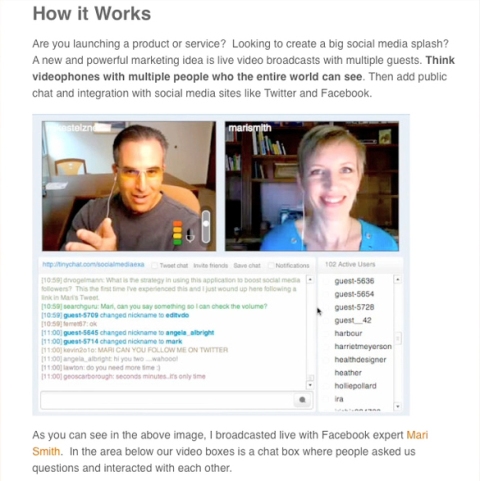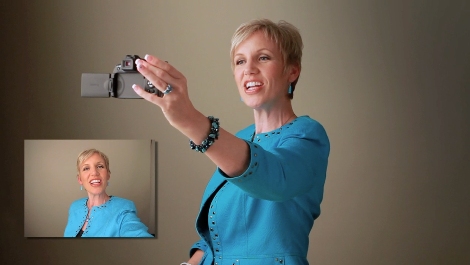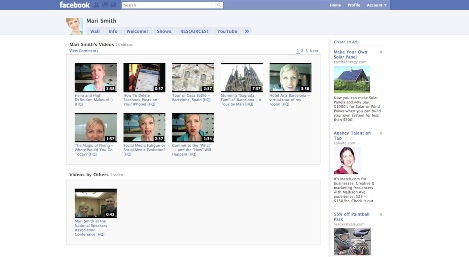 Video is hot! It adds a whole new dimension to your marketing. Are you looking to use video with your social media efforts, but feel a bit stuck?
Video is hot! It adds a whole new dimension to your marketing. Are you looking to use video with your social media efforts, but feel a bit stuck?
In this episode of Social Media Examiner TV, Mari Smith shares important tips, creative ideas and what you need to know to integrate video into your social media marketing. Also be sure to catch her ninja marketing tip at the end of the video.
Be sure to share your feedback and see the show notes with lots of useful links below.
Video Content
First you need to know what exactly you're going to put into your videos. Mari shares some ideas and then tells you two easy ways to create video content.
Screen Casts
This is where you capture your computer screen. Screen casts can be used to create different types of content. Here's the software you need:
- ScreenFlow for Mac users
- Camtasia Studio for PC users
- Jing Project – a free lite version of Camtasia
Video Interviews
Video interviews are also an easy way to create video content. Here are some tools you can use to conduct the interviews:
All you'll need to do is record these sessions through your ScreenFlow or Camtasia software to capture your screen and create a video interview.

Video Recording
Mari answers some questions from the Social Media Examiner Facebook page where our readers asked about the best practices to follow when creating videos. Here are some of the takeaways:
The ideal length of the video varies:
- For short tip videos: 60-90 seconds is about right
- For video shows: 10-15 minutes
Here are some important tips to make great videos:
Get World-Class Marketing Training — All Year Long!
Are you facing doubt, uncertainty, or overwhelm? The Social Media Marketing Society can help.
Each month, you’ll receive training from trusted marketing experts, covering everything from AI to organic social marketing. When you join, you’ll also get immediate access to:
- A library of 100+ marketing trainings
- A community of like-minded marketers
- Monthly online community meetups
- Relevant news and trends updates
- Make the first 3-5 seconds really count.
- Make sure you're high-energy and make strong eye contact with the camera.
- Have strong calls to action in the video.
- Work with an outline that has bullets instead of reading your text.
Video Equipment and Editing
Important Tips
First Mari shares some useful tips about the video equipment you need to create great videos:
- Microphone. Your audience will forgive you bad visuals, but you've got to have good audio. So use a microphone whenever you can.
- High definition. Most cameras shoot in high definition. Sephora sells makeup for high definition cameras. This is a whole new industry.
- Lighting. Have the natural light source shining onto your face. Lighting is crucial.
Camera equipment.
Then Mari suggests some camera equipment:

Discover Proven Marketing Strategies and Tips
Want to go even deeper with your marketing? Check out the Social Media Marketing Podcast! Publishing weekly since 2012, the Social Media Marketing Podcast helps you navigate the constantly changing marketing jungle, with expert interviews from marketing pros.
But don’t let the name fool you. This show is about a lot more than just social media marketing. With over 600 episodes and millions of downloads each year, this show has been a trusted source for marketers for well over a decade.

Video editing software.
Here are the links to the video editing software Mari mentions in the video:
- iMovie for Mac users
- Windows Movie Maker for PC users
Video Distribution
Finally, Mari gives you lots of ways to get your videos out there.
Get a YouTube channel.
A YouTube channel gives you additional SEO benefits because it's owned by Google. And you can customize your YouTube channel by giving it a branded skin.
Connect your YouTube account to your Facebook and Twitter accounts.
Here's how you do this. On your YouTube page, go to the top and:
- Click on Username
- Click on Account
- Click on Activity Sharing over on the left
- Select your different accounts to connect
Mari recommends just selecting “Like” and/or “Favorite” in the settings where you choose to automatically send updates onto the profiles you select here.
Publish your videos on Facebook.
Once you have your YouTube account connected to your Facebook account, you can come in and hit the “Like” button on your video. It will be published on your Facebook Profile wall with the little video player.
To get videos onto your Facebook business page you need to copy the URL of your video and paste it onto your wall, or you can try out some of the Facebook apps. Here are two Mari mentions:
Repost your video content.
Sometime after your video is published on your Facebook wall, as described above, be sure to repost your content. You do this by loading your YouTube video up to the default Facebook video tab.

And if you want to publish your video on another website, use the embed code for your video to publish it there.
Consider the YouTube alternatives.
You can use these services as alternatives or in addition to YouTube.
And you can also use TubeMogul to broadcast your video to a multitude of sites.
Try out the video widget tools.
Mari shares two of her favorite tools to create video widgets for your website. These widgets allow you to display a bunch of videos in a variety of ways:
Be sure to watch this video to pick up all of the little tips Mari shares to help you use videos successfully in your online marketing plan. And don't forget to listen for the Facebook marketing tip Mari shares at the end!
If you enjoy this episode of Social Media Examiner TV, make sure to tweet about it (use hashtag #SMEtv), share it on Facebook or even embed it on your blog.
What do you think? Do you have video marketing tips to share? We want to hear from you! Leave us a comment below.
Attention Agency Owners, Brand Marketers, and Consultants

Introducing the Marketing Agency Show–our newest podcast designed to explore the struggles of agency marketers.
Join show host and agency owner, Brooke Sellas, as she interviews agency marketers and digs deep into their biggest challenges. Explore topics like navigating rough economic times, leveraging AI, service diversification, client acquisition, and much more.
Just pull up your favorite podcast app, search for Marketing Agency Show and start listening. Or click the button below for more information.

